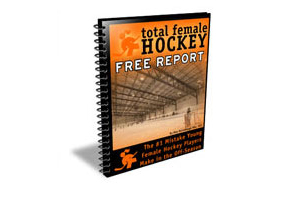Injury Season Is Here
I know what you’re thinking…
“It’s the end of the season, Kim. How can players get hurt now?”
It’s very simple.
It’s the change of seasons.
And I don’t just mean winter to spring – although it is nice to finally get out from under the deep freeze.
It’s the transition from hockey season to…
… Soccer
… Lacrosse
… Rugby
or whatever sport players are now moving onto now that the hockey season is done.
As you might know, in addition to being an on-ice instructor and a bench coach,
I’m also a strength and conditioning coach. In fact, I’ve been training players off
the ice for over 15 years. I actually started Total Female Hockey as an off-ice
training company.
And in the 15 plus years I’ve been training hockey players, I’ve seen a huge
number of injuries strike athletes as soon as they go from skating on the ice
to running around on a field.
It’s not because the players are out of shape. Most of the players I work with
have been skating 5 or more times a week and training off the ice with their
teams for almost 8 months by the time April rolls around. They are in great
hockey shape…
… and that’s why they are getting injured.
Let me explain.
Hockey is very much a LATERAL movement sport. Think about it – with every
stride you take (or every push the goalie does to make a save), your muscles
are generating lateral force. You might be moving straight ahead on your blades,
but you had to push your leg out to the side in order to move forward. Hockey
really is unique in that sense. Skating isn’t exactly the most natural movement around.
So while your body might be very well conditioned to generate and control
force laterally by the end of the season, you haven’t been training your muscles
and joints to move you LINEARLY for 8 months.
Linear movement – running, jogging – may be something you do in your team
warm-up or on a sprint or conditioning day with your team. But it isn’t specific
to the sport you are playing for 8 months of the year and therefore your body
becomes much stronger in the LATERAL movement plane.
So how does this lead to injury?
Sports like lacrosse, soccer and rugby are based on LINEAR movement. While
you absolutely need to have great lateral quickness in order to excel at these
sports, you aren’t generating nearly as much force in the lateral plane as you do
in hockey. So when players go from mostly lateral movement to mostly linear
movement, their muscles (especially around the hip and groin area) aren’t well
conditioned in that new movement plane to make the switch seamlessly.
So you end up with a lot of hip flexor strains, quadriceps pulls, hamstring strains
and groin pulls. These injuries can definitely happen on the ice as well, but
they are increasingly likely to happen when you are asked to sprint full out in
a way that your body hasn’t likely done very much in 8 months.
So how do we fix it?
I’m sorry to say there aren’t any magic healing potions for this. Many of these
strains and pulls could be avoided with proper warm-ups and stretching. But
some of them are simply a product of trying to go too hard too soon in a sport
and movement pattern that you just aren’t very well-trained for yet. Ideally,
there would be a training period where hockey players could transition back
into their “running” sports more slowly and not have to go full-tilt right away.
It’s really no different than the transition we see back to the ice in August and
September when players who have been focusing more on running sports
get back on the ice without enough lateral movement training and end up with
pulled groins, hip flexors and sore lower backs. Going from mostly linear
movement to mostly lateral movement causes a lot of injury issues as well.
That’s why I spend the last 6-8 weeks of the summer focusing on lateral
movement training with players to make sure they perform their best and avoid
injury once they hit the ice in the fall.
So this spring, make sure you warm-up properly before sprinting full-tilt and
remember to cool-down and stretch those hip, groin and leg muscles after you play.
I know they aren’t the most exciting things in the world to do, but they’ll
keep you on the field and off the injured list.
Work Hard. Dream BIG. Play Safe.
Your friend and coach,
Kim
Kim McCullough, MSc, YCS
Director & Founder, Total Female Hockey
www.totalfemalehockey.com

